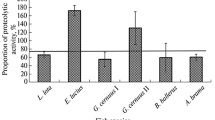Abstract
The antigenic structure of four aquatic Phycomycetes of the genusSaprolegnia with parasitic activity in fish was analyzed with immunoelectrophoresis and double diffusion techniques. It is shown that these serological tests might represent a valuable criterion for the identification of the fourSaprolegnia species:S. parasitica, S. ferax, S. delica, andS. diclina. A specific chromogenic reaction revealed the presence of a protease with chymotrypsin-like activity among the precipitation arcs obtained after immunoelectrophoresis. Analysis of this proteolytic activity by kinetic assay methods confirmed the results of the serological tests. Moreover estimates of the quantity of enzyme present in the cellular extract and in the culture medium were obtained. A possible relationship between the proteolytic activity and the host-parasite interaction was discussed.
Similar content being viewed by others
References
Biguet, J., Tran Van Ky, P., Fruit, J., and Andrieu, S., 1967. Identification d'une activité chymotryptique au niveau de fractions remarquables de l'extrait antigénique d'Aspergillus fumigatus. Répercussions sur le diagnostic immunologique de l'aspergillose.Rev. Immunol., Paris 31: 317–328.
Bizzozero, S. A., Kaiser, A. W., and Dutler, H., 1973. A numerical method for acquisition and processing of steady-state kinetic data contained in an entire progression curve. Application to the study of α-chymotrypsin-catalyzed hydrolysis.Eur. J. Biochem. 33: 292–300.
Gindrat, D., Peduzzi, R., Sijak, A., and Turian, G., 1970. Caractérisation morphologique, chimique et sérologique d'un mutant albinos deNeurospora crassa Shear et Dodge isolé de semences de mâche.Mycopath. Mycol. Appl. 41: 237–249.
Grabar, P., and Williams, C. A., 1953. Méthode permettant l'étude conjugée des propriétés électrophorétiques et immunochimiques d'un mélange de protéines. Applications au se'rum sanguin.Biochim. Biophys. Acta 10: 193–194.
Grimaldi, E., Peduzzi, R., Cavicchioli, G., Guissani, G., and Spreafico, E., 1973. Diffusa infezione branchiale da funghi attribuiti al genereBranchiomyces Plehn a carico dell'ittiofauna di laghi situati a nord e a sud delle Alpi.Mem. Ist. Ital. Idrobiol. 30: 61–96.
Lewis, D. H., 1973. Concepts in fungal nutrition and the origin of biotrophy.Biol. Rev. 48: 261–278.
Matsubara, H., and Feder, J., 1971. Other bacterial, mold and yeast proteases. In: The Enzymes. P. D. Boyer, editor. 3rd Ed., vol. 3, pp. 721–795. Academic Press, New York.
Morihara, K., 1974. Comparative specificity of microbial proteinases.Advan. Enzymology 41: 179–243.
Nicolet, J., Bannerman, E. N., and Krawinkler, M., 1974. Observation on precipitins against a peptidase with chymotrypsin-like activity ofMicropolyspora faeni, in sera of cattle exposed to mouldy hay.Path. Microbiol. 40: 237–238.
Nolard-Tintigner, N., 1971. Cause de la mort dans la Saprolégniose expérimentale du poisson.Bull. Cl. Sci. Acad. Roy. Belg. 57: 185–191.
Ouchterlony, ö., 1962. Diffusion-In-Gel methods for immunological analysis.Progr. Allergy 6: 30–154.
Peduzzi, R., and Turian, G., 1969. Etude immunochimique et électrophorétique de la condiationde Neurospora crassa.Experientia 25: 1178–1180.
Peduzzi, R., and Turian, G., 1972. Recherches sur la différenciation conidienne deNeurospora crassa. II. Comparaison immunologique des structures antigéniques du type sauvage conidiogène avec celles de deux mutants aconidiens.Ann. Inst. Pasteur 122: 923–942.
Scheidegger, J. J., 1955. Une micro-méthode de l'immunoélectrophorèse.Intern. Arch. Allergy 7: 103–110.
Stuart, M. R., and Fuller, H. T., 1968. Mycological aspects of diseased Atlantic salmon.Nature 217: 90–92.
Tran Van Ky, P., Vaucelle, T., Andrieu, S., Torck, C., Floc'h, F., and Quesnoit, P., 1969. Caractérisation de complexes enzymes-antienzymes dans les extraits de levure du genreCandida après Ìmmunoélectrophophoregramme en agarose.Mycopath. Mycol. Appl. 38: 345–357.
Turian, G., Peduzzi, R., and Lingappa, B. T., 1972. Conidial repression by phenethyl alcohol and its serological consequences inNeurospora crassa.Arch. Mikrobiol. 85: 333–340.
Uriel, J., 1963. Characterization of enzymes in specific immune-precipitates.Ann. N.Y. Acad. Sci. 103: 956–979.
Vanbreuseghem, R., 1966. Guide pratique de mycologie médicale et vétérinaire. Ed. Ed. Masson, Paris.
Warburg, O., and Christian, W., 1942. Isolierung und Kristallisation des GÄrungsferments Enolase.Biochem. Z. 310: 384–421.
Willoughby, L. G., 1968. Atlantic salmon disease fungus.Nature 217: 872–873.
Author information
Authors and Affiliations
Rights and permissions
About this article
Cite this article
Peduzzi, R., Bizzozero, S. Immunochemical investigation of four Saprolegnia species with parasitic activity in fish: Serological and kinetic characterization of a chymotrypsin-like activity. Microb Ecol 3, 107–118 (1977). https://doi.org/10.1007/BF02010400
Issue Date:
DOI: https://doi.org/10.1007/BF02010400



